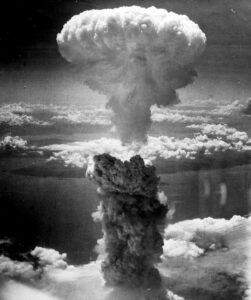 I am a child of the atomic age. The atomic bomb, that is, the threat of nuclear war and mass destruction, has been in my consciousness—sometimes in the background but frequently in the foreground—nearly all of my life.
I am a child of the atomic age. The atomic bomb, that is, the threat of nuclear war and mass destruction, has been in my consciousness—sometimes in the background but frequently in the foreground—nearly all of my life.
I was born on August 9, 1945 at the Lying Inn Hospital of the University of Chicago, the day that the second atomic bomb was dropped in Japan on the city of Nagasaki, killing tens of thousands of people. My birthplace, the U of C, was also the birthplace of the atomic bomb, which had been conceived there a couple of years before. Enrico Fermi and other scientists in the Manhattan Project carried out the first chain reaction on December 2, 1942 in a secret laboratory hidden in the university’s football stadium. Of course, when I let out my first shriek at the shock of birth and the awakening into life, I knew nothing of any of that.
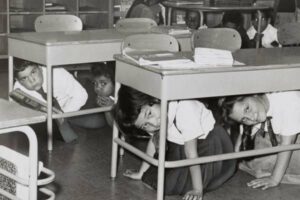 I first became conscious of the issue of nuclear war when I was eight years old. My parents had moved to Whittier, California, where my father was to manage a Co-op Grocery Store. The local public elementary school that I attended held “duck-and-cover” drills and we students had to get under our desks and put our hands over our heads. We were told this would protect us in the event of a nuclear attack. A duck-and-cover pubic service announcement of the era shows, among other scenarios, an elementary school class much like mine. I don’t remember ever discussing this with my teacher or my parents at the time, though I am sure that it is from that time that I began to experience the vague and chronic nuclear anxiety that so many of us of my generation felt and still feel.
I first became conscious of the issue of nuclear war when I was eight years old. My parents had moved to Whittier, California, where my father was to manage a Co-op Grocery Store. The local public elementary school that I attended held “duck-and-cover” drills and we students had to get under our desks and put our hands over our heads. We were told this would protect us in the event of a nuclear attack. A duck-and-cover pubic service announcement of the era shows, among other scenarios, an elementary school class much like mine. I don’t remember ever discussing this with my teacher or my parents at the time, though I am sure that it is from that time that I began to experience the vague and chronic nuclear anxiety that so many of us of my generation felt and still feel.
In 1957 Norman Mailer, after describing the post-war period in America, wrote about that vague anxiety in his famous essay “The White Negro”:
It is on this bleak scene that a phenomenon has appeared: the American existentialist—the hipster, the man who knows that if our collective condition is to live with instant death by atomic war, relatively quick death by the State as l’univers concentrationnaire, or with a slow death by conformity with every creative and rebellious instinct stifled (at what damage to the mind and the heart and the liver and the nerves no research foundation for cancer will discover in a hurry), if the fate of twentieth century man is to live with death from adolescence to premature senescence, why then the only life-giving answer is to accept the terms of death, to live with death as immediate danger, to divorce oneself from society, to exist without roots, to set out on that uncharted journey into the rebellious imperatives of the self.
Obviously, I was too young to understand those ideas, but those feeling of existential angst and rebellious attitudes would come to me later.
Throughout my elementary and secondary school years, first in Chicago and later when I lived in San Diego County, television frequently carried news or programs about the U.S. Strategic Air Command (SAC), a special force of bombers carrying nuclear weapons. We were told that SAC would deter war, but that if it failed to deter, American bombs would obliterate the Soviet Union, as was explained in the film “The Power of Decision” and other U.S. Air Force publicity into the 1960s.
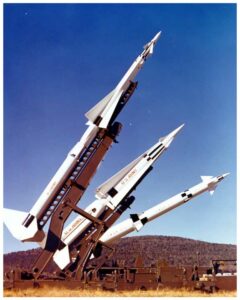 The military also publicized the U.S. Army’s defensive Nike Missile system deployed in and around cities throughout the country. I remember seeing Nike Missile bases in Chicago along Lake Shore Drive when I returned to visit my father’s family in the early 1960s. The Nikes we were told would defend us from incoming Soviet H-bombs.
The military also publicized the U.S. Army’s defensive Nike Missile system deployed in and around cities throughout the country. I remember seeing Nike Missile bases in Chicago along Lake Shore Drive when I returned to visit my father’s family in the early 1960s. The Nikes we were told would defend us from incoming Soviet H-bombs.
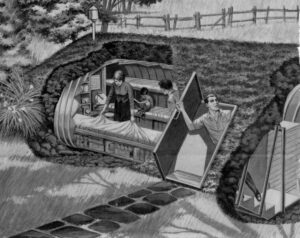 There were also TV shows and films about civil defense and fallout shelters. Some of these suggested that every suburban family should have a well-provisioned underground fallout shelter where mom, dad, and the kids could ride out the storm until the radioactive dust settled. New York, which had a population of 7.7 million, had 18,000 such shelters in 1963 and the Department of Defense had plans for 34,000 more. Where I now live in Brooklyn I occasionally see the yellow and black fallout shelter signs of the 1950s posted on some apartment buildings. Cities all over the country had the shelters. When the TV and radio told us or the alarms went off, we were all to hightail it to the shelter and wait for the all clear that would surely come.
There were also TV shows and films about civil defense and fallout shelters. Some of these suggested that every suburban family should have a well-provisioned underground fallout shelter where mom, dad, and the kids could ride out the storm until the radioactive dust settled. New York, which had a population of 7.7 million, had 18,000 such shelters in 1963 and the Department of Defense had plans for 34,000 more. Where I now live in Brooklyn I occasionally see the yellow and black fallout shelter signs of the 1950s posted on some apartment buildings. Cities all over the country had the shelters. When the TV and radio told us or the alarms went off, we were all to hightail it to the shelter and wait for the all clear that would surely come.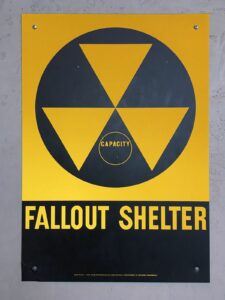
A small percentage of shelters were fortified underground bunkers stocked with emergency supplies, but these were rare and primarily built for high-ranking government officials. The majority of shelters, including nearly all those that were visibly marked, were known as “community shelters,” and by all accounts, they offered little special protection.
Many of the New York City shelters reportedly became overrun with rats as big as dogs.
At the time of the Berlin crisis in 1961, President John F. Kennedy told the country in a nationwide televised speech on July 25, that, “in the event of an attack, the lives of those families which are not hit in a nuclear blast and fire can still be saved if they can be warned to take shelter and if that shelter is available.”
The president went on say: “We owe that kind of insurance to our families and to our country. … The time to start is now. In the coming months, I hope to let every citizen know what steps he can take without delay to protect his family in case of attack. I know you would not want to do less.”
Though I do not remember it, in all likelihood I saw Kennedy make that speech, since I watched the national news every evening as well all did then. I was fifteen years old. Did I believe it? I don’t know. Talk of nuclear war and civil defense had by then become normalized, so I suppose I did.
At the time people discussed, analyzed, and even wrote poems about bomb shelters. One of the questions—the Noah’s Ark question—was whether or not one would have to defend one’s shelter gun-in-hand from neighbors who had had not had the foresight to prepare for the hard rain that was gonna fall.
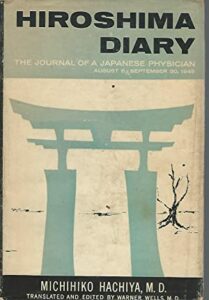 But by the time I was in high school, I was aware that all of the duck-n-cover and fallout shelter stuff was nonsense. In part that was because I had read Hiroshima Diary: The Journal of a Japanese Physician by Dr. Michihiko Hachiya, director of the Hiroshima Communications Hospital, who in his diary described the destruction and suffering caused by one A-bomb being dropped on his city.
But by the time I was in high school, I was aware that all of the duck-n-cover and fallout shelter stuff was nonsense. In part that was because I had read Hiroshima Diary: The Journal of a Japanese Physician by Dr. Michihiko Hachiya, director of the Hiroshima Communications Hospital, who in his diary described the destruction and suffering caused by one A-bomb being dropped on his city.
One H-bomb could take out the entire city of San Diego. Images of the A-bombs and H-bombs I’d seen in those films destroying actual Japanese cities or test sites with buildings built to be blown apart, were burned into my brain, sometimes actually worrying me, but more often just hovering in the background contributing to a lingering uneasiness.
 I was a junior in high school during the Cuban missile crisis in the fall of 1962 when it was learned that the Soviet Union had installed missile bases on Cuba that could carry nuclear warheads to the United States. Now, we learned, Soviet bombs were only 96 miles from the United States. President Kennedy demanded their removal. Soviet Premier Nikita Khrushchev and President Kennedy who negotiated the crisis held the fate of the world in their hands. For a couple of weeks, every night on television there were discussions of the dangerous developments and images of nuclear bombs. John F. Kennedy spoke to us through the TV, telling us we were on the “abyss of destruction.” Many people thought we might all be incinerated. When it ended, we were advised that we had escaped the “most terrible threat of holocaust since World War II.” When, we wondered, would it happen again?
I was a junior in high school during the Cuban missile crisis in the fall of 1962 when it was learned that the Soviet Union had installed missile bases on Cuba that could carry nuclear warheads to the United States. Now, we learned, Soviet bombs were only 96 miles from the United States. President Kennedy demanded their removal. Soviet Premier Nikita Khrushchev and President Kennedy who negotiated the crisis held the fate of the world in their hands. For a couple of weeks, every night on television there were discussions of the dangerous developments and images of nuclear bombs. John F. Kennedy spoke to us through the TV, telling us we were on the “abyss of destruction.” Many people thought we might all be incinerated. When it ended, we were advised that we had escaped the “most terrible threat of holocaust since World War II.” When, we wondered, would it happen again?
During the period from my high school graduation in 1963 until I finished college in 1968, nuclear war was not at the forefront of my consciousness. We all had other things on our minds. The television, that had been bringing us images of the civil rights movement through the early 1960s and now it brought us the Black urban rebellions and the anti-Vietnam War movement. Coming from a socialist, pacifist family, I had registered as a conscientious objector upon my graduation from high school in 1963 and for the moment had a draft deferment as a college student. The possibility of being called up and sent to kill or die in Vietnam pushed the more abstract idea of nuclear war further back into the recesses of my mind.
 After graduating from San Diego State College in 1968, I went for one semester to the Library School at the University of Chicago, returning to the place of my birth, the place of the bomb’s birth. One day, walking through the campus I came upon Henry Moore’s magnificent sculpture “Nuclear Energy,” located more or less on the site where the bomb had been developed. It seemed to me to depict both the atomic bomb and the human brain that conceived it. It appeared to be a tribute to the wonder of human intelligence and to its folly, to our genius and to our stupidity. Moore declined to say exactly what it represented or the source of the imagery.
After graduating from San Diego State College in 1968, I went for one semester to the Library School at the University of Chicago, returning to the place of my birth, the place of the bomb’s birth. One day, walking through the campus I came upon Henry Moore’s magnificent sculpture “Nuclear Energy,” located more or less on the site where the bomb had been developed. It seemed to me to depict both the atomic bomb and the human brain that conceived it. It appeared to be a tribute to the wonder of human intelligence and to its folly, to our genius and to our stupidity. Moore declined to say exactly what it represented or the source of the imagery.
Moore, who was British, was himself an opponent of the bomb.
When the Campaign for Nuclear Disarmament (CND) was launched in 1958, Moore was among its founder members. He had already sponsored its predecessor the National Campaign for the Abolition of Nuclear Weapons Tests (NCANWT). He also supported disarmament groups local to his home in Perry Green such as the Hertford Group of Nuclear Disarmament, which he donated to in 1959.
Such was Moore’s involvement in the CND that the critic John Berger proposed that his Falling Warrior, 1956-57 (LH 405) be used as their emblem, and a CND sponsored exhibition be held of the sculpture and its preparatory maquettes and working models. The exhibition was never held nor the emblem adopted, however, CND imagery would prove important to Moore.
In any case, Moore’s sculpture moved me as it had moved others.
The following year I returned to San Diego and attended the University of California at San Diego (UCSD) to study Literature with Fred Jameson, the literary critic, and occasionally sat in on classes of Herbert Marcuse, the Marxist philosopher. I find it interesting that I don’t remember any discussions of the issue of nuclear arms in those years at UCSD where (despite its implosion at the 1969 convention) SDS—Students for a Democratic Society—was still active on our campus protesting the Vietnam War and there was also a Third World Coalition of students of color protesting racism, while professors and graduate students discussed Marx, Freud, and Sartre day and night. There may have been some anti-nuclear discussions, but not that I remember. Perhaps because Richard Nixon became president and we had entered into a period of détente with the Soviet Union, the bomb became less of an issue. In any case, it was at that time that, after reading Sartre, that I came to think of myself as an existentialist; and perhaps it was living with the anxiety of the bomb, that brought me to that conclusion, as Mailer had suggested a dozen years before that it would.
I left graduate school in 1971, and once again returned to Chicago as part of the International Socialists’ labor-organizing project, becoming a steel worker for a short while and for several years a truck driver, active in helping to organize Teamsters for a Democratic Union. We on the left—or at least in my part of the left—were well aware of the issue of nuclear warfare, but it seldom came up, since we were focusing on more immediate issues: civil rights, the Vietnam War, and workers’ struggles for a decent life. We on the far left at that time were all engaged in party building, but our various parties, which opposed the U.S. war in Vietnam, only occasionally took up the issue of the atomic bomb.
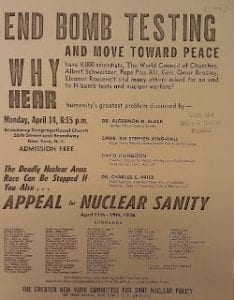 Because I had grown up in a pacifist family, I was aware of the anti-nuclear weapons movement, of organizations like the National Committee for a Sane Nuclear Policy, better known as SANE, that had been founded in 1957. In a big city like Chicago where I lived throughout the 1970s and into the early 1980s, one occasionally saw anti-nuclear-weapons activists demonstrating. Some came from the Quakers and the Unitarian Church or from some liberal Jewish Temple, some from the War Resisters League, while others were gray-haired idiosyncratic socialists. Occasionally there were some students, but the Peaceniks, as they were known, tended to be mature people, older folks. Compared to the young people in the streets demanding civil rights or protesting the Vietnam War, the peace and anti-nuclear movement seemed somewhat quaint. Of course, some of these folkloric Peaceniks were heroic draft resisters who had gone to prison for their beliefs and others became founders of the anti-Vietnam War movement. Another group, Women’s Strike for Peace seemed to be made up mostly of older women in the 1960s, but by the 1970s it had been transformed by the new feminism so that it combined the exuberance of the emerging women’s movement with the sense of urgency to end nuclear weapons.
Because I had grown up in a pacifist family, I was aware of the anti-nuclear weapons movement, of organizations like the National Committee for a Sane Nuclear Policy, better known as SANE, that had been founded in 1957. In a big city like Chicago where I lived throughout the 1970s and into the early 1980s, one occasionally saw anti-nuclear-weapons activists demonstrating. Some came from the Quakers and the Unitarian Church or from some liberal Jewish Temple, some from the War Resisters League, while others were gray-haired idiosyncratic socialists. Occasionally there were some students, but the Peaceniks, as they were known, tended to be mature people, older folks. Compared to the young people in the streets demanding civil rights or protesting the Vietnam War, the peace and anti-nuclear movement seemed somewhat quaint. Of course, some of these folkloric Peaceniks were heroic draft resisters who had gone to prison for their beliefs and others became founders of the anti-Vietnam War movement. Another group, Women’s Strike for Peace seemed to be made up mostly of older women in the 1960s, but by the 1970s it had been transformed by the new feminism so that it combined the exuberance of the emerging women’s movement with the sense of urgency to end nuclear weapons.
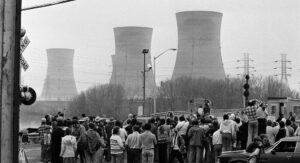 It was in 1980s that the anti-nuclear movement suddenly took off. It was not nuclear weapons or nuclear war that so unexpectedly made things nuclear a big deal, it was the nuclear power plant accident at Three Mile Island in Harrisburg, Pennsylvania, that led to a partial meltdown in a nuclear reactor releasing radioactive gases and iodine into the atmosphere. Local anti-nuclear power groups that had existed in various parts of the country prior to the Three Mile Island accident began to mobilize to shutdown nuclear reactors and to organize many local protests and a couple of large scale national demonstrations of between 100,000 and 200,000 people in late 1979. These demonstrations around nuclear power melded with the movement against nuclear weapons.
It was in 1980s that the anti-nuclear movement suddenly took off. It was not nuclear weapons or nuclear war that so unexpectedly made things nuclear a big deal, it was the nuclear power plant accident at Three Mile Island in Harrisburg, Pennsylvania, that led to a partial meltdown in a nuclear reactor releasing radioactive gases and iodine into the atmosphere. Local anti-nuclear power groups that had existed in various parts of the country prior to the Three Mile Island accident began to mobilize to shutdown nuclear reactors and to organize many local protests and a couple of large scale national demonstrations of between 100,000 and 200,000 people in late 1979. These demonstrations around nuclear power melded with the movement against nuclear weapons.
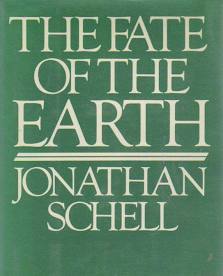 Then too, there is the fact that the era of U.S.-Soviet détente had ended and another Cold Warrior had been elected president: Ronald Reagan. Reagan’s anti-Communism was enough to make people worry about nuclear war, but his occasional off-hand remarks about using tactical nukes or fighting an actual nuclear war between the United States and the Soviet Union in Europe added to our anxiety.
Then too, there is the fact that the era of U.S.-Soviet détente had ended and another Cold Warrior had been elected president: Ronald Reagan. Reagan’s anti-Communism was enough to make people worry about nuclear war, but his occasional off-hand remarks about using tactical nukes or fighting an actual nuclear war between the United States and the Soviet Union in Europe added to our anxiety.
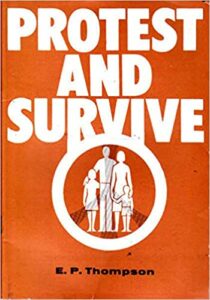 Then too the left took up the issue. In 1980, the great British labor historian E.P. Thompson, author of The Making of the English Working Class, who was also an anti-nuclear arms activist, published his pamphlet Protest and Survive. It was originally a parody of a British government civil defense pamphlet called Protect and Survive. The large English and European anti-nuclear movements, of which Thompson was a spokesperson, had reverberations in America. Another landmark of the anti-nuclear movement at the time was writer Jonathan Schell’s important The Fate of the Earth in which he argued that a nuclear war might destroy all human life and make the planet uninhabitable. We on the left now had a couple of tomes to educate us and provide a direction.
Then too the left took up the issue. In 1980, the great British labor historian E.P. Thompson, author of The Making of the English Working Class, who was also an anti-nuclear arms activist, published his pamphlet Protest and Survive. It was originally a parody of a British government civil defense pamphlet called Protect and Survive. The large English and European anti-nuclear movements, of which Thompson was a spokesperson, had reverberations in America. Another landmark of the anti-nuclear movement at the time was writer Jonathan Schell’s important The Fate of the Earth in which he argued that a nuclear war might destroy all human life and make the planet uninhabitable. We on the left now had a couple of tomes to educate us and provide a direction.
 All of this came together in 1982. I was working as an I.S. staff person and was in New York City on June 12, where I joined the demonstration that day of one million people in Central Park calling for an end to the nuclear arms race; at that time it was the largest political demonstration in U.S. history. Throughout the 1980s the anti-nuclear movement with its slogan—“Never Again” and brandishing Peter Kennard’s horrifying poster (left)—grew, and spread, and became more militant with thousands being arrested. It was about this time too that the Greenham Commons Women’s Peace Camp, protesting the British government’s installing nuclear cruise missiles at the Royal Air Force base there, caught everyone’s attention. Women chained themselves to the fence and many were arrested, and it lasted almost twenty years. The 1983 television film The Day After, about ordinary people and their experience of the the outbreak of a nuclear war between the United States and the Soviet Union, was seen by 100 million people in 39 million households and also contributed significantly to the anti-nuclear arms sentiment at the time.
All of this came together in 1982. I was working as an I.S. staff person and was in New York City on June 12, where I joined the demonstration that day of one million people in Central Park calling for an end to the nuclear arms race; at that time it was the largest political demonstration in U.S. history. Throughout the 1980s the anti-nuclear movement with its slogan—“Never Again” and brandishing Peter Kennard’s horrifying poster (left)—grew, and spread, and became more militant with thousands being arrested. It was about this time too that the Greenham Commons Women’s Peace Camp, protesting the British government’s installing nuclear cruise missiles at the Royal Air Force base there, caught everyone’s attention. Women chained themselves to the fence and many were arrested, and it lasted almost twenty years. The 1983 television film The Day After, about ordinary people and their experience of the the outbreak of a nuclear war between the United States and the Soviet Union, was seen by 100 million people in 39 million households and also contributed significantly to the anti-nuclear arms sentiment at the time.
In the mid-1980s, my wife Sherry Baron and I moved to Los Angeles where she did public health research at UCLA. I found work with Jobs with Peace, a remarkable campaign mounted by a number of unions and community organizations. Informed by the idea that the Cold War ought to be wound down, Jobs with Peace called for a transition from an economy based on military production—which in Los Angeles meant the aerospace industry producing fighters and bombers—to an economy based on production for society’s needs. The national Jobs with Peace Campaign was associated with SANE/Freeze, so one can say it formed part of the anti-nuclear movement. My work with Jobs with Peace had me knocking on doors in the harbor towns, Wilmington and San Pedro, talking with working class people about the need to make a transition while preserving union jobs, and the response was generally very good.
In the late 1980s my wife Sherry and I moved to Cincinnati where she had gotten a job with the National Institute of Occupational Safety and Health (NIOSH), part of the Centers for Disease Control and soon we were raising two children. The city was conservative, a political backwater for the left and busy with our family, our involvement in politics declined until the police killings of Black men led to a rebellion there in 2001. Involved in organizing protests against racist police, the bomb was in the background.
Still, we read the newspapers and followed international events and joined the movement against the first U.S. war on Iraq. I remained a socialist, now in Solidarity, a group formed by the merger of the I.S. and other two groups. We were aware of the tensions in the Middle East and that they might possibly lead to nuclear war and concerned about it, but once again there were other developments competing for our attention. The terrorist attack on the Twin Towers in September 2001 meant that Sherry spent a lot of time in New York City looking into the health affects on first responders and other workers in the area of the explosions as well as creating programs to help them. Once again a more immediate challenge pushed the nuclear question down on the agenda. Then there were the U.S. wars in Afghanistan and Iraq, and we joined the protests against those wars, which terrible as they were, did not seem likely to lead to nuclear war.
Some people believed that with the collapse of the Soviet Union in 1991 there would be a “peace dividend,” since the United States would no long have a mortal enemy. The government could spend less money on the military and more on social programs. And perhaps, said the optimists, it would be possible to phase out nuclear weapons. But that did not happen, though with the fall of the Soviet Union the anti-nuclear movements declined, perhaps because people believed war was now more unlikely. But nuclear weapons didn’t go away. As I am sure you know, at least nine nations have nuclear weapons and though five (the U.S., Russia, China, U.K. and France) have signed a treaty to stop the spread of nuclear weapons to other nations and promised—someday—to destroy their current stockpiles—there is no evidence that the number of nuclear weapons is being reduced. Four other nations—India, Pakistan, Israel, and North Korea—also have nuclear weapons but have not signed the treaty. Japan and Iran both appear to have the capacity to make a bomb, but have not done so.
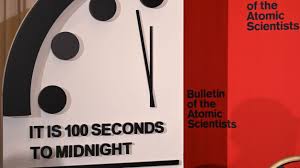 Now Turkey and Saudi Arabia want the bomb too and the Washington Post suggests that 2020 could be an “especially dangerous year.” What year, I wonder, has not been? In 1947, the Bulletin of Atomic Scientists began to publish the “Doomsday Clock” indicating how close the scientists thought the world was to nuclear war and destruction. In January of this year they announced that we were 100 seconds from Doomsday. We must be even closer now.
Now Turkey and Saudi Arabia want the bomb too and the Washington Post suggests that 2020 could be an “especially dangerous year.” What year, I wonder, has not been? In 1947, the Bulletin of Atomic Scientists began to publish the “Doomsday Clock” indicating how close the scientists thought the world was to nuclear war and destruction. In January of this year they announced that we were 100 seconds from Doomsday. We must be even closer now.
I have been and remain skeptical of the notion that the world’s governments, run as most of them are by groups of political gangsters who serve capitalist moguls, would ever take any step that limited or reduced their power by curtailing nuclear arms. Only a powerful international movement that seeks to change our economic and political system will make possible the elimination of nuclear weapons.
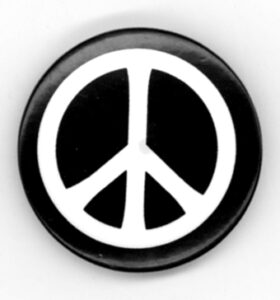 So, we continue to live with the fear that a nuclear war might be triggered by some incident in the Middle East or in Punjab. And we continue to wear button with the peace symbol that was created in 1958 by Gerald Holtom for the British Campaign for Nuclear Disarmament (CND). Of course now we have the overriding issue of global warming, and are living through the COVID-19 pandemic and the economic crisis it has caused, immediate issues pushing the danger of nuclear warfare into the background once more. But here it is, August again. I will turn 75 and so will my age-mate the atomic bomb. You and I will continue, as we know, to live in the shadow of the bomb until we create a movement to rid ourselves of it.
So, we continue to live with the fear that a nuclear war might be triggered by some incident in the Middle East or in Punjab. And we continue to wear button with the peace symbol that was created in 1958 by Gerald Holtom for the British Campaign for Nuclear Disarmament (CND). Of course now we have the overriding issue of global warming, and are living through the COVID-19 pandemic and the economic crisis it has caused, immediate issues pushing the danger of nuclear warfare into the background once more. But here it is, August again. I will turn 75 and so will my age-mate the atomic bomb. You and I will continue, as we know, to live in the shadow of the bomb until we create a movement to rid ourselves of it.


An interesting review, Dan, but what strikes me is what a difference a few years can make. You seem to have experienced the nuclear question as a back burner question, not so much in the public consciousness, but rather as a movement issue. Born in 1943 and raised in a town that had been settled by Quakers but which was dominated by Calvinists by the time I was growing up, I encountered the tail end of the Student Peace Union, which in many ways prefigured SDS as an American manifestation of the New Left. A coalition of radical pacifists and third camp socialists, while SPU was sensitive to issues of racial injustice, its central focus was nuclear disarmament. In my experience this was pushed aside both by the emergent of the civil rights movement and the Viet Nam war, though for a few years prior to that the issue of nuclear disarmament was central to many student activists.